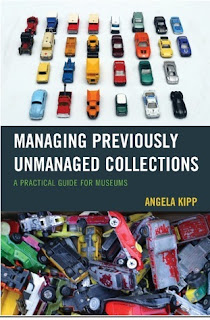Well look at me! I'm kind of so far sticking to this goal of reading through my pile of museum books to read! *pat on the back* And now I'm back with another review!
I'd been reading Angela Kipp's blog "Registrar Trek" for a while, so I was really excited when she announced she was writing a book, and then again when she said it was being published. Her blog about the life of a registrar/collections manager was insightful and full of thought (well-written and thought out, as well "Huh, I never thought of that before. That's an interesting thing to keep in mind" thoughts), and often funny and crazy (Pictures of her driving a forklift always kind of scared me: "Do I need to learn how to drive a forklift to work in collections?!?"). So when her book came out, I immediately bought it, but then like so many other books I buy, it got put in a pile of books to read, and then sat there... and sat there... and sat there (as I suffered guilt about all the other books I was excited to read and bought... too many books, not enough time). Over the years, I read a few sections of the book that were relevant to something I was working on at the time, but I have only now read the whole book, cover to cover, and now I absolutely wish I had read it sooner!
One of things I love about this book is that it's not only about how to tackle the objects in a previously unmanaged collection (If you work in collections, or in a museum/historical society where you have access to the collections, you know what we're talking about: objects everywhere, piled up haphazardly, likely not in protective housing, maybe dirty; if you're the one who works with the collections, you know there are no numbers, no tags, no paperwork... *shudder*), but it's about the mindset you need to do the work. And it's not a "Get in there and get to it!" mindset; it's about focusing your time, your effort, your sanity, and even about knowing when to step away. Kipp gives us an overview and reminders on page 1 that immediately set the reader up for this work:
- Think of the whole collection, not single objects.
- You are a collections manager, now think like a project manager.
- See the big picture, work in small steps.
- Don't be spellbound by numbers.
- You are not the white knight.
- You are not a collections management machine.
She also includes "Logical Exits," which to me at first seemed like a loser's way of thinking ("What? You can't do the whole job? You're going to give up?!?"), but after I read about them, I realized that they make sense: There's a very good chance you can't do everything, either because the project is so large or there's not enough time, and sometimes you also just need to be able to step away for the sake of your sanity. Kipp includes 4 logical exits in working with and cleaning up previously unmanaged collections, and provides the reader with how to recognize and plan subsequent logical exits. As someone who pushes herself to exhaustion sometimes because she doesn't want to look like a failure, I appreciate that Kipp points out the importance of knowing these logical exits, "points at which you will have the collection in a condition that allows you to leave it for the next lucky person to take over [or to just step away for a while]... the points at which you can stop without risking that everything you've done so far... was a waste of time" (xii-xiii).
But the book isn't just about being in the right frame of mind. Kipp talks about how to first tackle the mess, documenting where everything was when you first saw it; how to begin organizing the mess; how to organize the room it's going to go into; storage materials; dealing with the board, volunteers, and budgets; and even about making personal, human connections with other collections professionals, people in other industries, and people in your community who might be able to help you or advocate for you. She doesn't talk about nitty-gritty details like how to number a collection or which CMS to use; she leaves those aspects for other books. Instead, she starts waaaaaay back at the very beginning, which few other collections/museums books do. The numbering system or the database you use comes after you've been daunted by the scope of the collection/mess, and Kipp's book is one of the few (actually, the only one that I've seen, but she does reference a couple of others) that helps you tackle that daunting mess.
Managing Previously Unmanaged Collections: A Practical Guide for Museums, 2016
The upsides:
- This gives an overview of how to tackle collections messes, with great ideas of how to get started and the early steps you need to take.
- Logical Exits that can keep you sane or give you "a goal toward which you can work" (172).
- This book isn't just useful if you're starting at Square One. It's also good if you have some amount of organization and cataloguing, and her tips are useful even if you're decently organized and catalogued.
- Her writing and the included horror and success stories make you feel like you have a friend in this work and you're not alone. Others have been through similar issues and have lived to tell the tales.
- I want a collections job even more now! I have so many ideas of how to jump in and get a mess under control!
